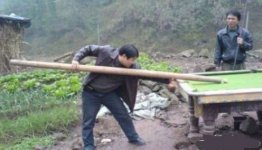I was wondering the other day: when you use a sufficiently large tip, wouldn't draw miscues become impossible, because the cue would be stopped from going too low by the table surface?
If so, I wonder what the optimum miscue-prevention tip diameter would be. Back of the envelope guess: 50% of the radius is generally regarded as the optimal strike point for max backspin, without tempting fate to 60% out from the equator which is the hard limit iirc from Dr Dave's work. 50% of the cue ball radius is 0.5625 inches, which is 14.287 millimeters.
So would it be theoretically impossible to miscue on a draw with a 14.3mm tip and a nearly level stroke?
Not saying that the larger tip wouldn't introduce other problems in the game, or that the cloth wouldn't suffer from repeated strikes, but imagine how much more stroke you could put on the ball if you knew there was zero chance of going too low.
If so, I wonder what the optimum miscue-prevention tip diameter would be. Back of the envelope guess: 50% of the radius is generally regarded as the optimal strike point for max backspin, without tempting fate to 60% out from the equator which is the hard limit iirc from Dr Dave's work. 50% of the cue ball radius is 0.5625 inches, which is 14.287 millimeters.
So would it be theoretically impossible to miscue on a draw with a 14.3mm tip and a nearly level stroke?
Not saying that the larger tip wouldn't introduce other problems in the game, or that the cloth wouldn't suffer from repeated strikes, but imagine how much more stroke you could put on the ball if you knew there was zero chance of going too low.
